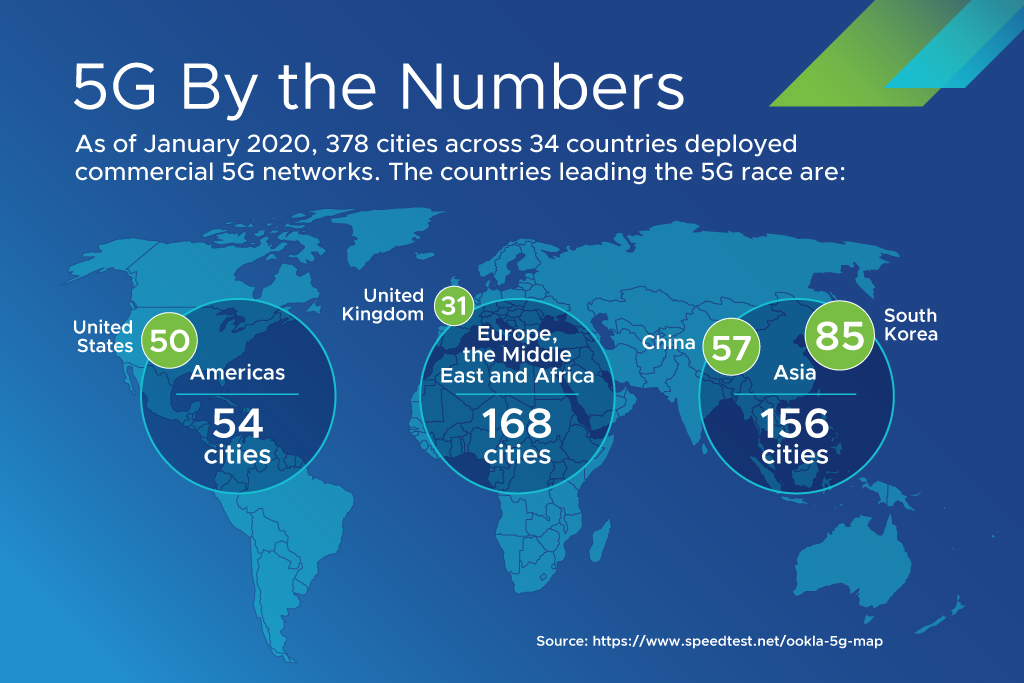We’ve been saying it for years: 5G could affect our lives more dramatically than any technological innovation since the internet itself.
Why? The experts say 5G will help us realize the potential of a fully connected world. Fast, intelligent internet connectivity enabled by 5G technology could create $3.6 trillion in economic output and 22.3 million jobs by 2035.
Just as the internet was the catalyst for the Web, 5G will be transformative in propelling the next great wave of emerging technology.
Much-anticipated tech innovations like smart cities, smart manufacturing, driverless cars, and telemedicine could become possible via 5G connectivity.
Simply put, the full potential of IoT, edge computing, and AI will not be realized without 5G. The question is: when will 5G go from buzzword to reality?
Breaking It Down: 5G
So, what is 5G and how does it work? I’m glad you asked.
5G stands for “fifth generation,” as in the fifth generation of cellular network technology. To be more specific, 5G is a type of telecommunications network that will provide mobile, land and cable service to consumers and businesses worldwide.
Today’s telco networks (4G) are optimized for video and data streaming. 4G transformed how we use our phones, making every person a potential broadcaster and/or consumer of streaming video content. With 5G, we’ll see another transformation that could make next-gen technologies like virtual and augmented reality, AI and even drones part of our everyday lives without requiring a lot of specialized equipment.
Five Potential Benefits of 5G:
- Super-fast broadband: Faster service and streaming, particularly in high-density areas (i.e. sports stadiums).
- Ultra-reliable low-latency communication: Faster transmission of data, which supports use cases like autonomous cars.
- Massive machine-type communications: Allowing many devices to transmit data at the same time, enabling use cases like smart cities.
- High reliability, high availability: Allows a system or system components to be continuously operational for a desirably long length of time.
- Efficient energy usage: Reduces the amount of energy required to provide products and services.
The Tech behind 5G
5G will require a new vision and a new network infrastructure, along with new operating and business models.
Before consumers enjoy 5G’s many potential benefits, service providers must invest in a virtualized and cloud-based infrastructure. 5G requires both a software-driven architecture and what is known as “network functions virtualization” (NFV) to be successful.
Government and private investments stem from the belief that 5G networks will grow and evolve quickly without the cost typically associated with building traditional network infrastructure. Thanks to the move from a hardware-based to cloud-first (or software-defined) infrastructure, telecommunications providers can drive down the cost for building 5G networks, while expanding the reach and improving performance.
When coupled with technology solutions such as the internet of things, artificial intelligence, or big data, 5G holds the potential to deliver large-scale societal value.
You, Me and 5G: What’s the Impact On the Average Consumer?
If you’ve turned on the TV or radio this year, you’ve probably seen or heard advertisements about 5G. But what is all the hype about? What does it mean for you as a customer?
According to Shekar Ayyar, EVP and general manager of the Telco and Edge Cloud business at VMware, 5G will provide a variety of consumer benefits. On a basic level, new phones will deliver all the capabilities of 5G networks. “We may see a mobile phone battle heat up as phone makers work to bring the best phones to market as quickly as possible,” says Ayyar.
It also means that as consumers, we’ll see more personalized experiences. Let’s take driverless cars, for example. To become fully autonomous, driverless cars need to communicate with other vehicles to avoid accidents and minimize congestion. These cars will also need to communicate with sensors embedded in traffic lights, road signs, and pavement. And they’ll need to get responses instantly—which is where low-latency 5G networks come in.
Healthcare is another industry primed for 5G-enabled innovation. Here are some examples:
- Trips to the doctor’s office might become as rare as house calls, thanks to virtual visits enabled by low-latency, HD-quality wireless networks.
- Wearable or implanted medical devices could capture and transmit your vital signs to healthcare providers, allowing them to detect early warning signs of heart attacks, strokes or other life-threatening events.
- High-speed wireless networks could also enable telesurgery, where specialists in one hospital control equipment in another facility hundreds of miles away.
For the workforce, 5G could also mean new opportunities to develop skills and jobs in new roles, like smart manufacturing. As intelligent technology evolves, businesses will also likely see improvements in efficiency, profitability, and worker satisfaction.
Innovate Today, Change Tomorrow
While major carriers are busy installing limited versions of 5G in cities around the globe, devices capable of accessing 5G networks are just starting to appear, and ultra-high-speed deployments are still several years away.
According to Telecompaper, as of January 2020, 378 cities across 34 countries deployed commercial 5G networks. The countries leading the 5G race are:

So, when will you be able to access 5G?
5G is technically here, but so far, it's a little underwhelming. And unless the stars align for your location, the wireless carrier you subscribe to and the smartphone you own, you probably can't use 5G’s full benefits yet. But that should change as more cities come online and more 5G devices become available.
By 2024 there will be more than 1.5 billion of us connected to 5G, according to Ericsson.
AT&T, Verizon, T-Mobile and Sprint have all launched their 5G networks, but there are caveats. First, there are only a handful of 5G-compatible devices on the market, though that number is growing. By year's end, we'll not only see the first 5G iPhone, but we also expect most wireless networks to offer nationwide coverage. That's when we'll begin to see the full potential of 5G.
From Buzz to Reality
While some industries have clearly defined use cases that could generate greater impact, 5G deployment will happen in phases. To ensure 5G deployment accelerates and its components and interdependencies are understood, there must be strong collaboration between stakeholders.
Regulators, industry associations, network operators, service/technology providers and public-private partnership organizations also must engage in continuous dialogue to address the challenges facing widespread 5G adoption worldwide. This collaboration is also needed to maximize the opportunities 5G will bring across sectors.
As 5G towers continue to spread and underlying technology advances continue to make their way from labs into consumer devices, the 5G experience will improve. At some point over the next few years, 5G-powered smartphones, tablets, laptops, wearables, and XR will be common. Meanwhile, 5G automotive, agricultural, and city-scale infrastructure initiatives will be well underway. Each will start out with a base level of 5G performance, and then get better over time.
Realistically, you can expect that process to continue with frequent developments over the next 10 or so years—just in time for 6G to kick off in 2030.
